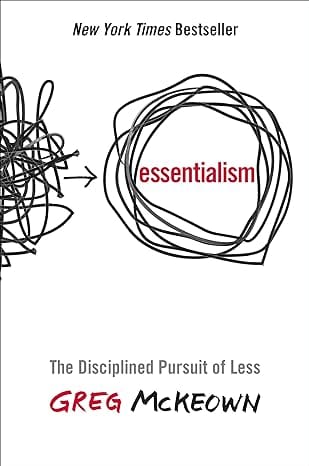Book Review - Essentialism: The Disciplined Pursuit of Less

From the first four pages, I was hooked. The opening story of the capable executive, who was stretched too thin and needed to focus only on what truly mattered, spoke to me. It was as if the author had written about me. Immediately I knew this wouldn't be just another book to add to my "Read" list on Goodreads; rather, it would be one that I would learn from, make positive changes with, and continue to refer back to long after finishing it. Read on for more about Essentialism: The Disciplined Pursuit of Less, by Greg McKeown.
The book is divided into four sections, each designated to answer one of the following questions:
What is the core mind-set of an essentialist?
How can we discern the trivial many from the vital few?
How can we cut out the trivial many?
How can we make doing the vital few things almost effortless?[1]
What is the core mind-set of an essentialist?
After painting the picture of the problem, like being stretched too thin, majoring in minors, and constantly doing but not getting anywhere, McKeown introduces the solution: essentialism. Chapter 1 goes on to define essentialism as "the relentless pursuit of less but better... in a disciplined way"[2]. Another key element of essentialism is focusing on the right things, or the essential things. The opposite of the Essentialist way is the Non-essentialist way, which is "the undisciplined pursuit of more"[3]. McKeown postulates that one reason for the pervasiveness of nonessentialism is that we've "lost our ability to filter what is important and what isn't", otherwise known as decision fatigue [4]. Personally, I experienced the unpleasant consequences of decision fatigue as I read the book, drowning in the Non-essentialist way. So much so that I could barely put the book down, as I was in relentless pursuit of a solution.
Another "aha!" moment arose when McKeown explained the origin of the word priority. For centuries, only the singular version of the word existed. The intent being that there can only be one priority. When we created the plural version, priorities, we opened the door to the Non-essentialist way.
Chapter 2 explores our power to choose and the importance of choosing to exercise our ability to choose. Instead of thinking "I have to do X", as would a Non-essentialist, Essentialists carefully exercise their right to choose, saying "I choose to do X." This simple reframing reminds readers that what we do is our choice.
Chapter 3 emphasizes the importance of discerning between what is essential and what is non-essential when making choices.
Chapter 4 introduces the concept of trade-offs when choosing and reinforces the criticality of understanding and considering trade-offs. It tells the story of Southwest Airlines' competitors ignoring the trade-offs of both maintaining their original strategy while simultaneously attempting to replicate Southwest's low-cost practices. Because the competitor ignored the trade-offs of these two incompatible strategies, they suffered expensive losses. This story reminded me of what happened when some organizations struggled to successfully adopt Agile Auditing. These organizations saw others finding success with Agile Auditing, so they adopted Agile Auditing practices, such as stand-ups, sprints, and ceremonies, while maintaining their original mindset or strategy. So instead of choosing to adopt an outcomes-focused mindset of agility and implementing practices essential to support that mindset, they kept the previous mentality without understanding the trade-offs and found little to no success, often reverting back to older and outdated ways of working.
With a solid understanding of the essentialist mindset, readers move to the second section of the book, titled "Explore".
How can we discern the trivial many from the vital few?
In the section titled "Explore", readers learn that if they're constantly on the go or too busy to stop and think, they aren't able to evaluate their choices and determine what is essential vs trivial (or non-essential). And without reserving time and space for thinking and evaluating choices, it just won't happen. We think we'll get around to it when we have time, but that time to sit and think rarely surfaces unless we intentionally create and protect it.
For those of you who have read Beyond Agile Auditing and those of you familiar with the Three Ways of DevOps, this sounds familiar to you. In Beyond Agile Auditing, I discuss the importance of reserving time for improvements and learning, using explanations and examples relatable in an audit setting. During speaking engagements, I typically end with an ask of the audience: to create (and protect) time when they return to work to evaluate what they've learned from the presentation or the event, decide what to do with what they've learned, and start taking action on it. Translated into the language of the Essentialist, my ask of attendees is to create time to evaluate their choices, discern the vital few from the trivial many, and start working toward the vital few.
The author also illustrates this in practice using an example of blocking time to write to book itself. He dedicated eight hours each day to writing Essentialism. When reading that example, I flashed back to my own experience writing Beyond Agile Auditing. Although I didn’t reserve specific blocks of time each day to write, I ensured I met my goal of writing at least 800 words each day. Looking back, setting aside the same time each day, as Mckeown did, would have been even more helpful. If I ever write a second book, I’ll take that approach.
Chapter 8 hit me with another “aha!” moment, as it spelled out the importance of sleep. In order to properly prioritize the essential items, and say “no” to nonessential things, we need adequate sleep. Without it, we’re unable to think clearly and distinguish between the essential and nonessential. Now, this wasn’t the first time I’ve read that sleep is important, but the way McKeown drove the point home through storytelling, data, and compelling arguments resulted in an impactful revelation for me.
For too long, I have sacrificed sleep to prioritize other things, thinking that would enable me to accomplish more. And maybe it did, but the “more” that I accomplished was more of the trivial many, rather than the vital few. Granted, some of the things I exchanged sleep for were vital or essential, but many were not. Going forward, I’m committed to getting adequate sleep so I can effectively tell the difference between what’s essential and what isn’t.
How can we cut out the trivial many?
Now that readers are equipped with the ability to distinguish between essential (the vital few) and nonessential (the trivial many), they learn how to eliminate the nonessential.
The first step, explained in Chapter 10, is to gain clarity of purpose. How many times have you been in a meeting where the attendees are discussing something but not making progress or accomplishing anything? Only when someone asks “what problem are we trying to solve?” or “what are we trying to accomplish?” does the group move forward. That clarity of purpose was the key.
McKeown summarizes the moral of the story as follows:
When there is a serious lack of clarity about what the team stands for and what their goals and roles are, people experience confusion, stress, and frustration. When there is a high level of clarity, on the other hand, people thrive.[5]
Another question McKeown suggests Essentialists use to drive clarity is “How will we know when we have succeeded?”[5]. Personally I will be adding that to my own toolkit.
To eliminate the nonessential, we need to be able to say “no”. In chapter 11, McKeown teaches us how to do that. Although my son may disagree, I struggle to say “no”. The fear of letting people down drives me to say “yes” even when I should really say “no”. I’m well aware that I need to decline more often, but how? Thankfully McKeown gives readerd tips, including:
- Separating the decision from fhe relationship you have with the requestor
- Focusing on the trade-off (or asking "What do I have to say "no" to if I say "yes" to this?")
- Seeking respect over popularity
He also gives readers a list of ways to gracefully decline. This is a section to bookmark and return to often.
How can we make doing the vital few things almost effortless?
This section of the book covers what we in the auditing world call “sustainable remediation.” Said another way, in this section McKeown teaches readers how to make Essentialism a regular practice, rather than a trend or fad that we quickly drop, reverting back to our non-essentialist ways.
To make Essentialism effortless, McKeown suggests:
- Using buffers to "reduce the friction caused by the unexpected" [6]
- Removing obstacles to progress
- Encouraging progress and celebrating small wins
- Creating routines to encourage Essentialism
- Focusing on the present, instead of the past and/or future.
As with any behavioral change, McKeown reminds readers that this takes time. Consistent and intentional practice with the concepts in the book can make Essentialism “more natural and instinctive”. [7]
Conclusion
I highly recommend this book. The author connects with readers and makes the concepts within the book very relatable, resulting in many “aha!” moments. Then readers get tools and techniques to use to put the concepts of Essentialism into practice.
Have you read the book yet? What did you learn from it?
[1] McKeown, G. (n.d.). Essentialism: The Disciplined Pursuit of Less. Random House. TOC
[2] McKeown, G. (n.d.). Essentialism: The Disciplined Pursuit of Less. Random House. p. 5
[3] McKeown, G. (n.d.). Essentialism: The Disciplined Pursuit of Less. Random House. p.14
[4] McKeown, G. (n.d.). Essentialism: The Disciplined Pursuit of Less. Random House. p.15
[5] McKeown, G. (n.d.). Essentialism: The Disciplined Pursuit of Less. Random House. p. 121
[6] McKeown, G. (n.d.). Essentialism: The Disciplined Pursuit of Less. Random House. p. 184
[7] McKeown, G. (n.d.). Essentialism: The Disciplined Pursuit of Less. Random House. p. 232
